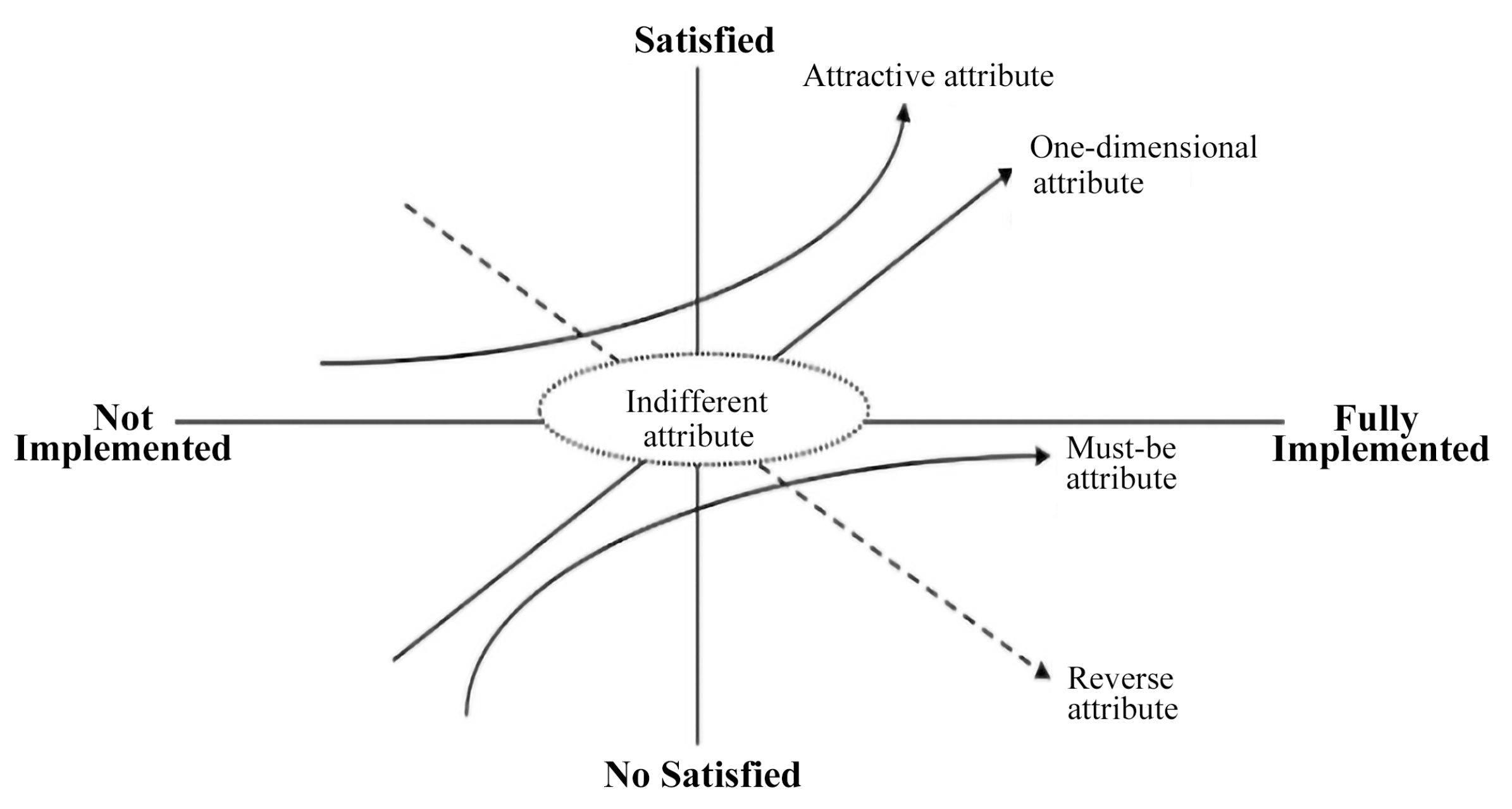Sustainable Innovative Design of Elderly-Friendly Smart Medical Products: An Integrated Model
Abstract
:1. Introduction
- Based on the fuzzy Kano model, Kansei engineering, and TRIZ, this study proposes a sustainable innovation design framework currently lacking in the field of smart healthcare products for the elderly. This framework addresses the deficiency in Kansei engineering’s application to product design, which often neglects the innovativeness of design solutions, and it complements the TRIZ field by accounting for users’ emotional needs. This provides methodological guidance for the sustainable innovative design of other product types;
- By innovatively using the systematic classification function of the fuzzy Kano model, this study addresses the irrationality in the screening process of core words of emotional needs in the traditional semantic differential method, thereby enhancing the significance level of core words of emotional needs in improving user satisfaction.
- To achieve sustainable innovation in the design of elderly-friendly smart medical products, enabling continuous iteration and optimization to meet the complex and changing emotional needs of the elderly;
- To provide a theoretical basis and practical guidance for the government and related industries in formulating policies on CMEC, promoting the innovation of elder-friendly smart medical products, and improving the quality of elderly care services.
2. Literature Review
2.1. Sustainable Innovative Design of Elderly-Friendly Smart Medical Products
2.2. Kansei Engineering
2.3. Fuzzy Kano Model
2.4. TRIZ
2.5. Sustainable Innovation Design Framework for Elderly-Friendly Smart Medical Products
3. Research Framework
3.1. Analysis of Emotional Needs of the Elderly
3.1.1. Elderly-Friendly Smart Medical Product Attribute Category Analysis
3.1.2. Construction of Vocabulary of Emotional Needs
3.2. Extraction of Core Emotional Needs of the Elderly
3.2.1. Construction of Key Vocabulary of Emotional Needs
3.2.2. Construction of Core Vocabulary of Emotional Needs
3.3. Generation of Sustainable Innovative Design Solutions for Elderly-Friendly Smart Medical Products
4. Empirical Case Studies
4.1. Analysis of Emotional Needs of the Elderly Regarding Smart Blood Pressure Monitors
4.1.1. Smart Blood Pressure Monitor Product Attribute Category Analysis
4.1.2. Construction of Vocabulary of Emotional Needs for Smart Blood Pressure Monitor Products
4.2. Extraction of Core Emotional Needs of the Elderly Regarding Smart Blood Pressure Monitors
4.2.1. Construction of Key Vocabulary of Emotional Needs for Smart Blood Pressure Monitor Products
4.2.2. Construction of Library of Core Emotional Needs for Smart Blood Pressure Monitor Products
4.3. Generation and Realization of Sustainable Innovative Design Solutions for Smart Blood Pressure Monitor Products
4.3.1. Generation Stage of Sustainable Innovation Design for Smart Blood Pressure Monitor Products
4.3.2. Realization Stage of Sustainable Innovation Design Solution for Smart Blood Pressure Monitor Products
5. Discussion
5.1. Research Advantages
5.2. Policy Implications
5.2.1. Implications for Enterprise-Level Research
- Deepen the understanding of user needs and product positioning: before proposing innovative design solutions for the smart blood pressure monitor, this study had already identified that elderly users prefer three key product attributes: “portability”, “appearance design”, and “functionality”. This conclusion was drawn after extensively collecting and analyzing smart blood pressure monitor pictures and descriptions from major e-commerce platforms and academic literature. This comprehensive understanding of user needs and product positioning ensured a smooth connection between demands and the design. Hence, enterprises must deeply understand the specific needs and preferences of elderly users through meticulous market research. This includes understanding their basic needs, expected needs, and attractive needs in the use of medical products. Enterprises should position their products according to these needs to ensure that the design direction matches the actual needs of the users;
- Promote the integration of Kansei engineering and technological innovation: the core idea of the integrated framework combining the fuzzy Kano model, Kansei engineering, and TRIZ is to ensure that the product innovation process is guided by users’ emotional needs. For example, in designing a smart blood pressure monitor, we first identified three core emotional needs: “no assembly required”, “small”, and “concise data display”. These needs were then mapped to propose four innovative design solutions (S1, S2, S3, and S4) for the smart blood pressure monitor, ensuring that the designs meet the emotional needs of the elderly while also maintaining innovation. Thus, when designing elderly-friendly smart medical products, enterprises should integrate the concept of Kansei engineering into the innovation process and should consider the emotional value and innovative design of the products. This implies that the product should not only fulfill the medical needs with regard to functionality but also bring comfort and pleasure to the elderly users in terms of sensory experience;
- Establishment of a management mechanism for continuous innovation and improvement: the integrated framework of the fuzzy Kano model, Kansei engineering, and TRIZ proposed in this study is merely a method to facilitate sustainable innovation in the design of elderly-friendly smart medical products. However, to truly achieve sustainable innovation in product design, fostering innovative thinking within the design team is the key driving force. Therefore, enterprises should establish a management mechanism for continuous innovation and improvement and encourage team members to use TRIZ and other innovation methods to resolve problems in the design and production process. Enterprises need to cultivate the problem awareness and problem-solving skills of the employees and improve the team’s ability to think creatively and solve problems systematically. Meanwhile, the enterprise should establish a mechanism to quickly respond to market changes, collect user feedback in a timely manner, and use it to rapidly improve products for achieving continuous product iteration and optimization.
5.2.2. Implications for Government-Level Research
- Facilitate collaborative innovation among industry, universities, and research institutes: the practical foundation of the sustainable innovation design framework for elderly-friendly smart medical products is not yet particularly solid, and the innovative design solutions for the smart blood pressure monitor remain at the conceptual stage, requiring further practical validation. In fact, advancing the elderly-friendly smart medical products industry requires close collaboration among various departments and entities. In this process, the government should play the role of a bridge to promote cooperation among enterprises, universities, research institutes, and other relevant parties to jointly promote the sustainable and innovative design of elderly-friendly smart medical products. The government can strengthen exchanges and cooperation among various parties by establishing innovation platforms, funding joint R&D projects, and organizing industry exchange meetings. In addition, the government can promote education and training programs for cultivating talent with expertise in elderly-friendly design and smart medical technology to support the long-term development of this industry;
- Encourage the demonstration and promotion of the application of smart medical products in the field of CMEC: in the process of collecting and analyzing the emotional needs of smart blood pressure monitor users, this study found that many elderly users experience anxiety about using smart devices. To address this issue, the government can encourage the demonstration and promotion of the application of elderly-friendly smart medical products in the field of CMEC through the establishment of demonstration zones and demonstration projects. This approach would provide companies with a practical platform to gather user feedback and optimize product performance, thereby significantly reducing the resistance elderly users may feel toward using these products. The government can also raise public awareness of elderly-friendly smart medical products through media publicity and public education to promote social recognition and acceptance of these products;
- Encourage cross-sectoral collaboration to integrate medical and elderly resources: elderly-friendly smart medical products are just one aspect of the broader CMEC services. To accelerate the development of CMEC, the government should play a role in cross-sectoral coordination and integrate resources in the fields of medical care, elderly care, science, and technology. By establishing a cross-sectoral collaboration platform to promote information sharing, resource integration, and collaborative innovation, the government can help enterprises better understand the needs of the elderly while providing them with the necessary support, such as market access, qualifications, and professional guidance.
5.3. Research Limitations and Future Prospects
6. Conclusions
- In the design of elderly-friendly smart medical products, the emotional needs of users provide the direction for product innovation, and the innovation of product design solutions is a strong guarantee for meeting these needs. The mutual connection between them is key to achieving sustainable innovation in the design of elderly-friendly smart medical products;
- The integration of Kansei engineering and TRIZ enables the mapping of users’ emotional needs to innovative design solutions for elderly-friendly smart medical products. The fuzzy Kano model effectively addresses the inherent limitations of the semantic differential method, enhancing overall user satisfaction;
- The innovative design of the smart blood pressure monitor based on the sustainable innovation design framework can solve the development problems of upstream suppliers and the sales problems of downstream retailers. More importantly, the designed device was popular among the elderly, confirming that the integrated framework can be used to guide product design and the design scheme development process for smart blood pressure monitors and further verifying the feasibility of the integrated framework for promoting sustainable innovative design of elderly-friendly smart medical products;
- The sustainable innovative design of elderly-friendly smart medical products in this study considers the emotional needs of the elderly, which not only can help the elderly maintain an independent life and enhance their self-management ability through iterative optimization of elderly-friendly smart medical product design and the provision of personalized services, significantly reducing the pressure on community health service centers and alleviating the current situation of the uneven distribution of medical resources, but also promotes the collection and analysis of relevant medical and elderly health data, providing valuable information resources for policymakers and promoting the development of intelligent CMEC.
Author Contributions
Funding
Institutional Review Board Statement
Informed Consent Statement
Data Availability Statement
Conflicts of Interest
Appendix A
| Serial Numbers | Engineering Parameters | Serial Numbers | Engineering Parameters |
|---|---|---|---|
| 01 | Weight of moving object | 21 | Power |
| 02 | Weight of stationary object | 22 | Loss of energy |
| 03 | Length of moving object | 23 | Loss of substance |
| 04 | Length of stationary object | 24 | Loss of information |
| 05 | Area of moving object | 25 | Loss of time |
| 06 | Area of stationary object | 26 | Quantity of substance, quantity of things |
| 07 | Volume of moving object | 27 | Reliability |
| 08 | Volume of stationary object | 28 | Measurement accuracy |
| 09 | Speed | 29 | Manufacturing precision, production precision |
| 10 | Force | 30 | External harm affects the object or system |
| 11 | Stress or pressure | 31 | Object (or system)-generated harmful factors |
| 12 | Shape | 32 | Ease of manufacture, more generally, ease of production |
| 13 | Stability of the object’s composition | 33 | Ease of operation |
| 14 | Strength | 34 | Ease of repair |
| 15 | Duration of action by a moving object | 35 | Adaptability or versatility |
| 16 | Duration of action by a stationary object | 36 | Device or system complexity |
| 17 | Temperature | 37 | Difficulty of detecting and measuring |
| 18 | Illumination intensity | 38 | Extent of automation |
| 19 | Use of energy by moving object | 39 | Extent of automation |
| 20 | Use of energy by stationary object |
Appendix B
| Serial Numbers | Inventive Principles | Serial Numbers | Inventive Principles |
|---|---|---|---|
| 01 | Segmentation | 21 | Rushing through |
| 02 | Extraction | 22 | Convert harm into benefit |
| 03 | Local quality | 23 | Feedback |
| 04 | Asymmetry | 24 | Mediator |
| 05 | Consolidation | 25 | Self-service |
| 06 | Universality | 26 | Copying |
| 07 | Nesting | 27 | Dispose |
| 08 | Counterweight | 28 | Replacement of mechanical system |
| 09 | Prior counteraction | 29 | Pneumatic or hydraulic construction |
| 10 | Prior action | 30 | Flexible membranes or thin films |
| 11 | Cushion in advance | 31 | Porous material |
| 12 | Equipotentiality | 32 | Changing the color |
| 13 | Do it in reverse | 33 | Homogeneity |
| 14 | Spheroidality | 34 | Rejecting and regenerating parts |
| 15 | Dynamicity | 35 | Transformation of properties |
| 16 | Partial or excessive action | 36 | Phase transition |
| 17 | Transition into a new dimension | 37 | Thermal expansion |
| 18 | Mechanical vibration | 38 | Accelerated oxidation |
| 19 | Periodic action | 39 | Inert environment |
| 20 | Continuity of useful action | 40 | Composite materials |
Appendix C. Smart Blood Pressure Monitor Product Satisfaction Questionnaire
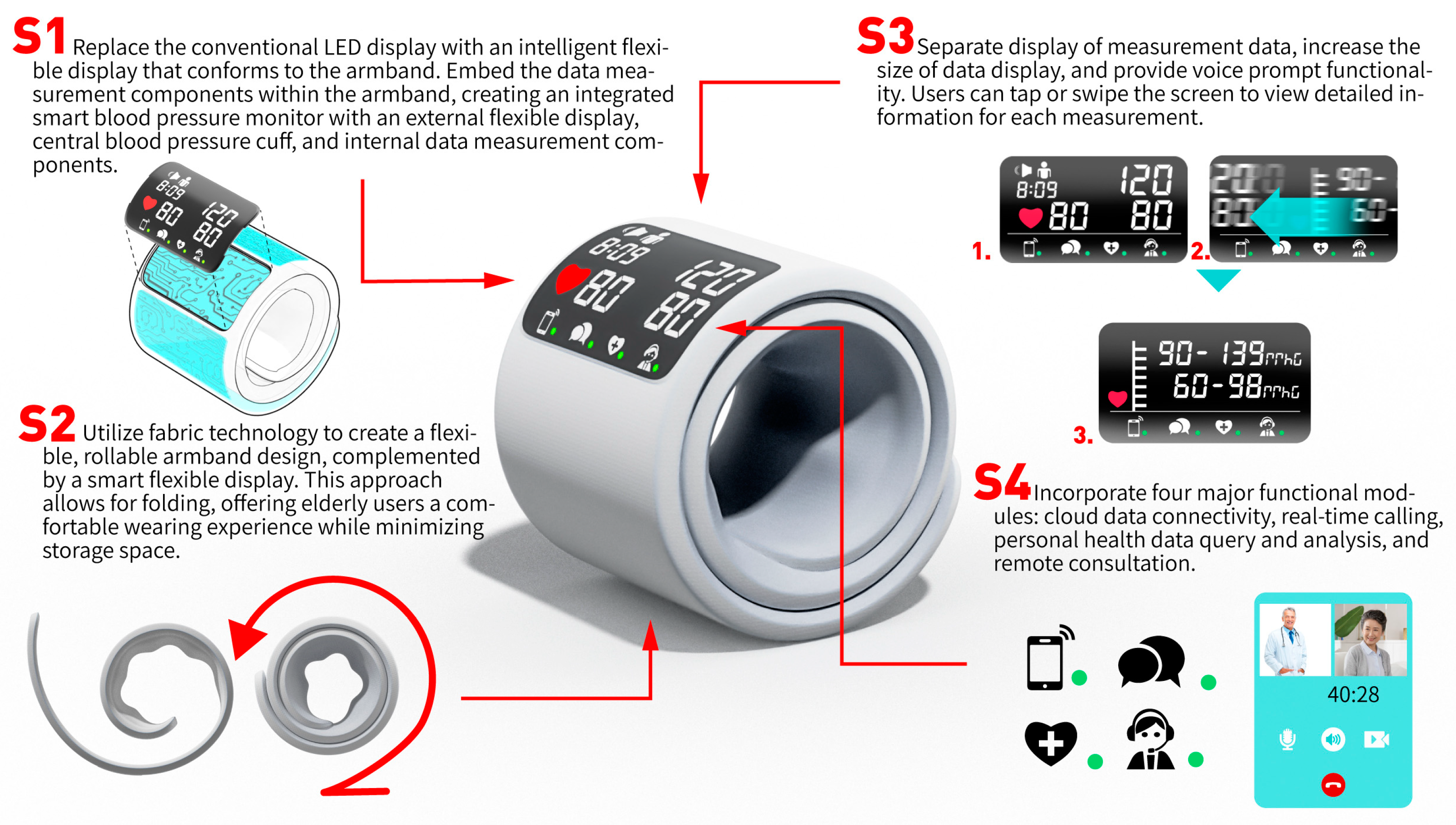
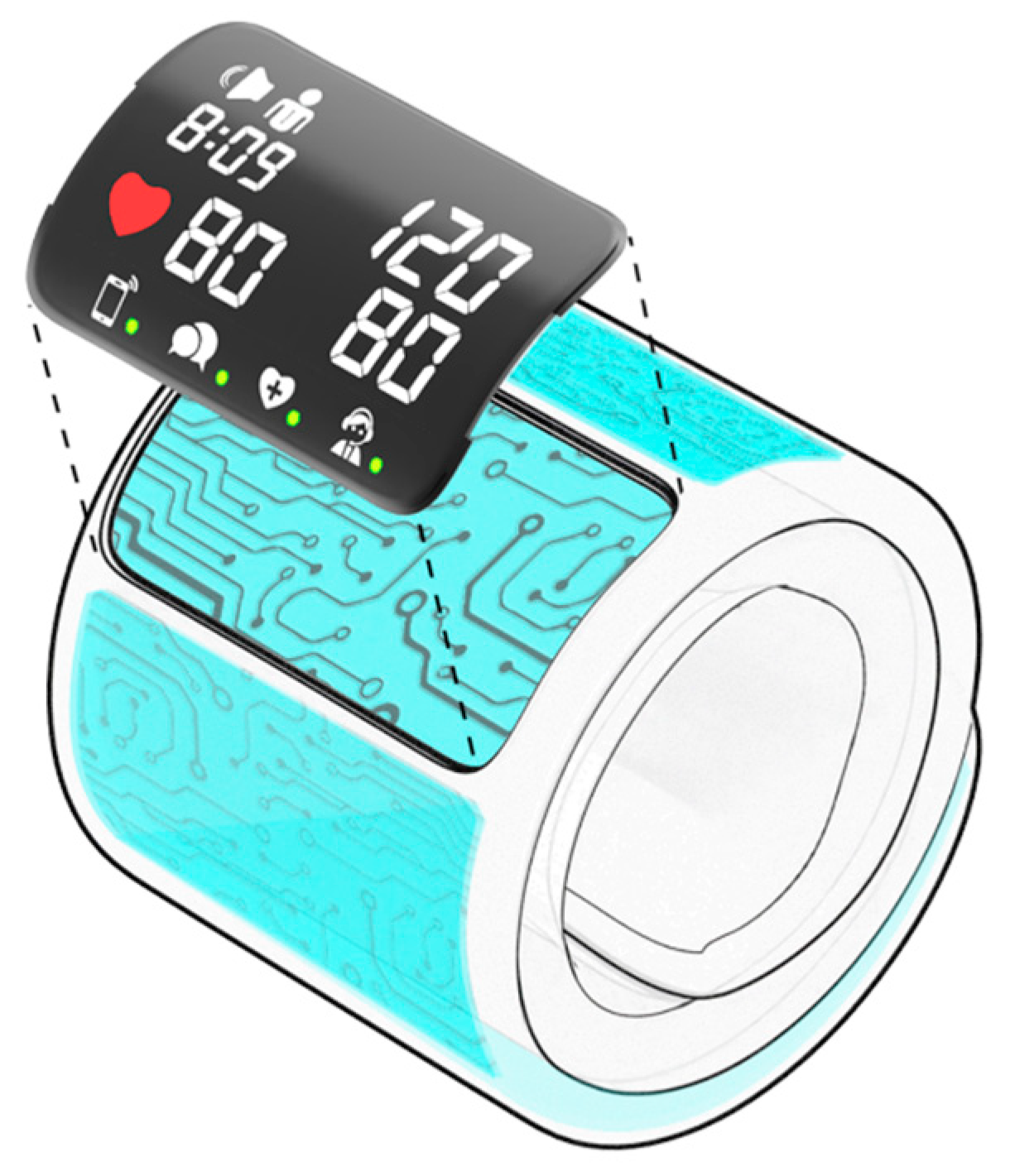
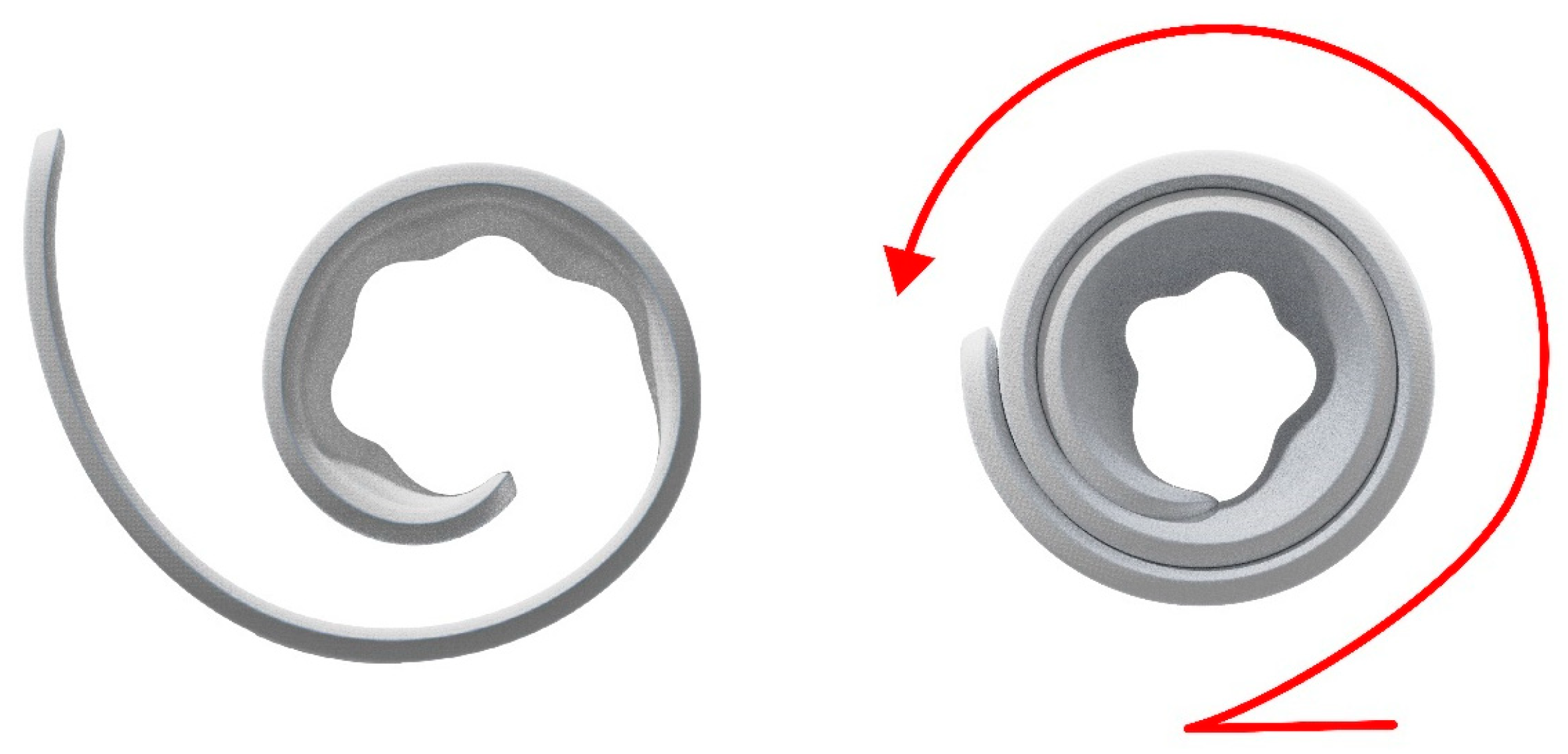
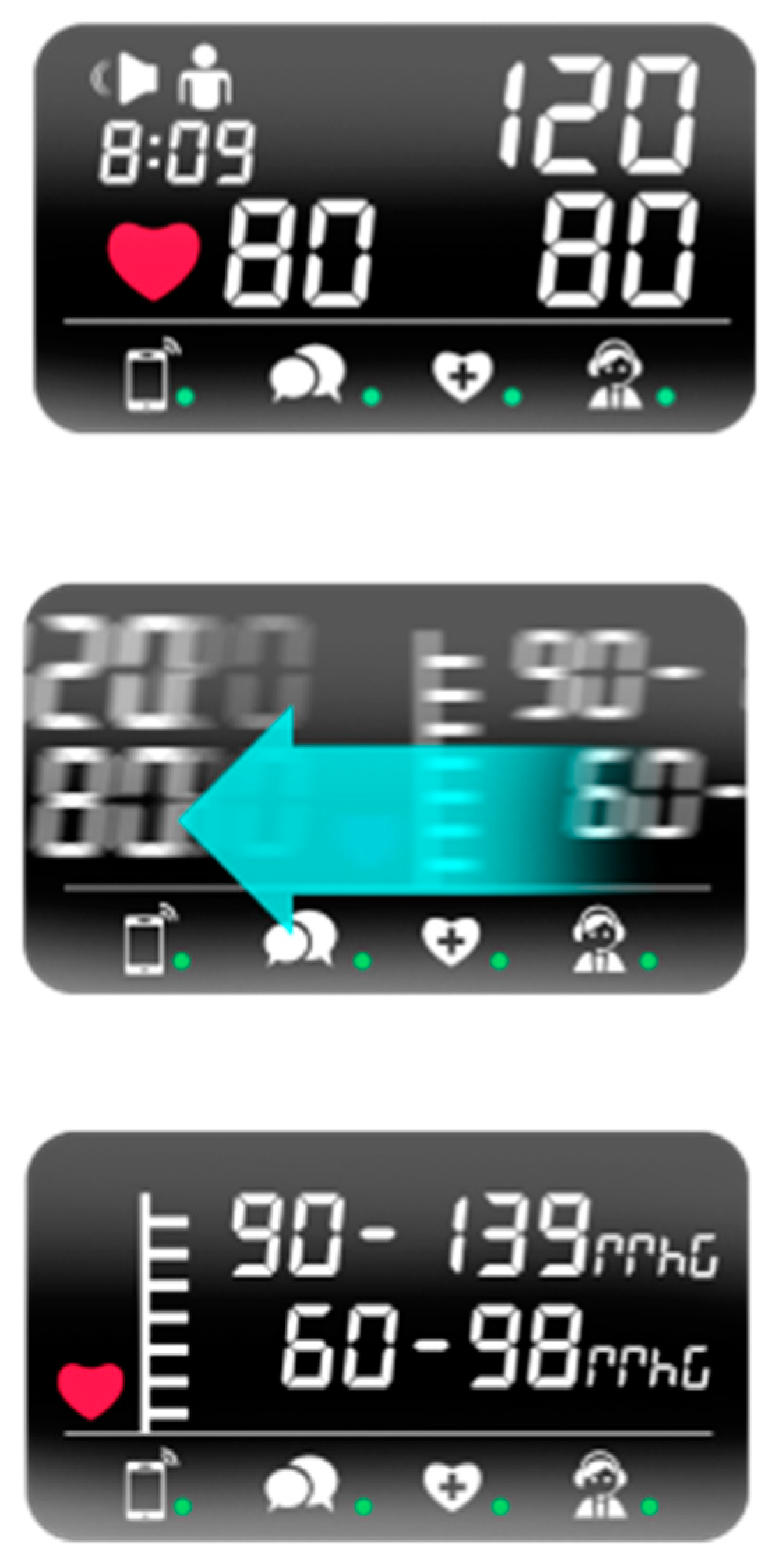

| ○Male | ○Female |
| ○Below 40 | ○41 to 60 | ○61 to 80 | ○Above 80 |
| ○Yes | ○No |
| ○Very dissatisfied | ○Dissatisfied | ○Neutral | ○Satisfied | ○Very satisfied |
| ○Very dissatisfied | ○Dissatisfied | ○Neutral | ○Satisfied | ○Very satisfied |
| ○Very dissatisfied | ○Dissatisfied | ○Neutral | ○Satisfied | ○Very satisfied |
| ○Very dissatisfied | ○Dissatisfied | ○Neutral | ○Satisfied | ○Very satisfied |
| ○Very dissatisfied | ○Dissatisfied | ○Neutral | ○Satisfied | ○Very satisfied |
References
- Wang, J.; Wang, Y.; Cai, H.; Zhang, J.; Pan, B.; Bao, G.; Guo, T. Analysis of the status quo of the Elderly’s demands of medical and elderly care combination in the underdeveloped regions of Western China and its influencing factors: A case study of Lanzhou. BMC Geriatr. 2020, 20, 338. [Google Scholar] [CrossRef] [PubMed]
- Gerke, S.; Babic, B.; Evgeniou, T.; Cohen, I.G. The need for a system view to regulate artificial intelligence/machine learning-based software as medical device. NPJ Digit. Med. 2020, 3, 53. [Google Scholar] [CrossRef] [PubMed]
- Gao, S.; He, L.; Chen, Y.; Li, D.; Lai, K. Public perception of artificial intelligence in medical care: Content analysis of social media. J. Med. Int. Res. 2020, 22, e16649. [Google Scholar] [CrossRef]
- Ge, Y.; Wang, L.; Feng, W.; Zhang, B.; Liu, S.; Ke, Y. The challenge and strategy selection of healthy aging in China. Manag. World 2020, 36, 86–96. [Google Scholar] [CrossRef]
- Luo, G.; Thomas, S.B.; Tang, C. Automatic Home Medical Product Recommendation. J. Med. Syst. 2012, 36, 383–398. [Google Scholar] [CrossRef]
- Wang, Z.; Cui, L.; Guo, W.; Zhao, L.; Yuan, X.; Gu, X.; Tang, W.; Bu, L.; Huang, W. A design method for an intelligent manufacturing and service system for rehabilitation assistive devices and special groups. Adv. Eng. Inform. 2022, 51, 101504. [Google Scholar] [CrossRef]
- Christopher, G.; Facal, D. Emotion regulation and mental health in older adults. Front. Psychol. 2023, 14, 1173314. [Google Scholar] [CrossRef]
- Shareef, M.A.; Kumar, V.; Dwivedi, Y.K.; Kumar, U.; Akram, M.S.; Raman, R. A new health care system enabled by machine intelligence: Elderly people’s trust or losing self control. Technol. Forecast. Soc. Chang. 2021, 162, 120334. [Google Scholar] [CrossRef]
- Lopes, A.M.; Fam, D.; Williams, J. Designing sustainable sanitation: Involving design in innovative, transdisciplinary research. Des. Stud. 2012, 33, 298–317. [Google Scholar] [CrossRef]
- Vinodh, S.; Kamala, V.; Jayakrishna, K. Integration of ECQFD, TRIZ, and AHP for innovative and sustainable product development. Appl. Math. Model. 2014, 38, 2758–2770. [Google Scholar] [CrossRef]
- Ding, M.; Sun, M.; Luo, S. Product color emotional design based on 3D knowledge graph. Displays 2024, 81, 102622. [Google Scholar] [CrossRef]
- Duan, Y.; Yang, M.; Huang, L.; Chin, T.; Fiano, F.; de Nuccio, E.; Zhou, L. Unveiling the impacts of explicit vs. tacit knowledge hiding on innovation quality: The moderating role of knowledge flow within a firm. J. Bus. Res. 2022, 139, 1489–1500. [Google Scholar] [CrossRef]
- Jiang, H.; Zou, L.; Huang, D.; Feng, Q. Continuous Blood Pressure Estimation Based on Multi-Scale Feature Extraction by the Neural Network with Multi-Task Learning. Front. Neurosci. 2022, 16, 883693. [Google Scholar] [CrossRef]
- Singh, A.P.; Pradhan, N.R.; Luhach, A.K.K.; Agnihotri, S.; Jhanjhi, N.Z.; Verma, S.; Kavita; Ghosh, U.; Roy, D.S. A Novel Patient-Centric Architectural Framework for Blockchain-Enabled Healthcare Applications. IEEE Trans. Ind. Inform. 2021, 17, 5779–5789. [Google Scholar] [CrossRef]
- Wu, C.-M.; Chuang, C.Y.; Chen, Y.-J.; Chen, S.-C. A new estimate technology of non-invasive continuous blood pressure measurement based on electrocardiograph. Adv. Mech. Eng. 2016, 8, 1687814016653689. [Google Scholar] [CrossRef]
- Yuan, B.; Ye, J.; Wu, X.; Yang, C. Applying Latent Dirichlet Allocation and Support Vector Regression to the Aesthetic Design of Medical Nursing Beds. J. Comput. Inf. Sci. Eng. 2023, 23, 051014. [Google Scholar] [CrossRef]
- Ren, Z.; Guo, F.; Hu, M.; Qu, Q.; Li, F. A consumer-oriented kansei evaluation model through online product reviews. J. Intell. Fuzzy Syst. 2023, 45, 10997–11012. [Google Scholar] [CrossRef]
- Wang, C.-H. Integrating Kansei engineering with conjoint analysis to fulfil market segmentation and product customisation for digital cameras. Int. J. Prod. Res. 2015, 53, 2427–2438. [Google Scholar] [CrossRef]
- Chanyachatchawan, S.; Yan, H.-B.; Sriboonchitta, S.; Huynh, V.-N. A linguistic representation based approach to modelling Kansei data and its application to consumer-oriented evaluation of traditional products. Knowl.-Based Syst. 2017, 138, 124–133. [Google Scholar] [CrossRef]
- Ge, Y.; Wang, S.; Han, R.; Peng, J.; Zhang, Z.; Hong, Y.; Yang, Y. Application of Kansei Engineering in aircraft design. Ind. Text. 2023, 74, 534–541. [Google Scholar] [CrossRef]
- Jiao, Y.; Qu, Q.-X. A proposal for Kansei knowledge extraction method based on natural language processing technology and online product reviews. Comput. Ind. 2019, 108, 1–11. [Google Scholar] [CrossRef]
- Sheu, D.D.; Chiu, M.-C.; Cayard, D. The 7 pillars of TRIZ philosophies. Comput. Ind. Eng. 2020, 146, 106572. [Google Scholar] [CrossRef]
- Ko, Y.-T. Modeling a hybrid-compact design matrix for new product innovation. Comput. Ind. Eng. 2017, 107, 345–359. [Google Scholar] [CrossRef]
- Shi, F.; Sun, S.; Xu, J. Employing rough sets and association rule mining in KANSEI knowledge extraction. Inf. Sci. 2012, 196, 118–128. [Google Scholar] [CrossRef]
- Yang, W.; Cao, G.; Peng, Q.; Sun, Y. Effective radical innovations using integrated QFD and TRIZ. Comput. Ind. Eng. 2021, 162, 107716. [Google Scholar] [CrossRef]
- Wang, M.; Shaari, N.; Abidin, S.Z.; He, Y. Elderly clothing upgrading in product-service system design using extended Kansei Engineering methodology. Int. J. Cloth. Sci. Technol. 2024, 36, 687–707. [Google Scholar] [CrossRef]
- Wang, M.; Shaari, N.; Abidin, S.Z.; He, Y. Product color emotional design adaptive to product shape feature variation. Color Res. Appl. 2019, 44, 811–823. [Google Scholar] [CrossRef]
- Cao, X.; Watanabe, M.; Ono, K. How Character-Centric Game Icon Design Affects the Perception of Gameplay. Appl. Sci. 2021, 11, 9911. [Google Scholar] [CrossRef]
- Álvarez Gil, M.; Lubiano, M.A.; de la Rosa de Sáa, S.; Sinova, B. Analyzing data from a fuzzy rating scale-based questionnaire. A case study. Psicothema 2015, 27, 182–191. [Google Scholar] [CrossRef]
- Lyu, H.-M.; Sun, W.-J.; Shen, S.-L.; Zhou, A.-N. Risk Assessment Using a New Consulting Process in Fuzzy AHP. J. Constr. Eng. Manag. 2020, 146, 04019112. [Google Scholar] [CrossRef]
- Xu, Q.; Jiao, R.J.; Yang, X.; Helander, M.; Khalid, H.M.; Opperud, A. An analytical Kano model for customer need analysis. Des. Stud. 2009, 30, 87–110. [Google Scholar] [CrossRef]
- Suhonen, R.; Stolt, M.; Launis, V.; Leino-Kilpi, H. Research on ethics in nursing care for older people: A literature review. Nurs. Ethics 2010, 17, 337–352. [Google Scholar] [CrossRef]
- Zhang, L.; Zhang, L.; Jin, C.; Tang, Z.; Wu, J.; Zhang, L. Elderly-Oriented Improvement of Mobile Applications Based on Self-Determination Theory. Int. J. Hum.-Comput. Interact. 2024, 40, 1071–1086. [Google Scholar] [CrossRef]
- van Nes, N.; Cramer, J. Product lifetime optimization: A challenging strategy towards more sustainable consumption patterns. J. Clean. Prod. 2006, 14, 1307–1318. [Google Scholar] [CrossRef]
- Kim, S.; Moon, S.K. Sustainable product family configuration based on a platform strategy. J. Eng. Des. 2017, 28, 731–764. [Google Scholar] [CrossRef]
- Hossain, S.M.; Chakrabortty, R.K.; El Sawah, S.; Ryan, M.J. Sustainable modular product architecture design by Bi-level leader-follower joint optimization with switching-based meta-heuristic algorithm. J. Clean. Prod. 2021, 306, 127108. [Google Scholar] [CrossRef]
- He, B.; Mao, H. Digital Twin-Driven Product Sustainable Design for Low Carbon Footprint. J. Comput. Inf. Sci. Eng. 2023, 23, 060805. [Google Scholar] [CrossRef]
- Smith, S.; Smith, G.; Shen, Y.-T. Redesign for product innovation. Des. Stud. 2012, 33, 160–184. [Google Scholar] [CrossRef]
- Corradini, C.; D’Ippolito, B. Persistence and learning effects in design innovation: Evidence from panel data. Res. Policy 2022, 51, 104452. [Google Scholar] [CrossRef]
- Levy, P. Beyond Kansei Engineering: The Emancipation of Kansei Design. Int. J. Des. 2013, 7, 83–94. [Google Scholar]
- Oztekin, A.; Iseri, A.; Zaim, S.; Nikov, A. A Taguchi-based Kansei engineering study of mobile phones at product design stage. Prod. Plan. Control 2013, 24, 465–474. [Google Scholar] [CrossRef]
- Zhu, X.M.; Yang, Z. A Design Research of Household Steam Massage Deceit that Based on KANSEI Engineering. Adv. Mater. Res. 2012, 557, 2438–2441. [Google Scholar] [CrossRef]
- Hsu, L.-H.; Hsiao, Y.-H. Facilitating Green Supply Chain in Dental Care through Kansei Healthscape of Positive Emotions. Int. J. Environ. Res. Public Health 2019, 16, 3507. [Google Scholar] [CrossRef]
- Liu, Z.; Wu, J.; Chen, Q.; Hu, T. An improved Kansei engineering method based on the mining of online product reviews. Alex. Eng. J. 2023, 65, 797–808. [Google Scholar] [CrossRef]
- Song, W.; Xie, X.; Huang, W.; Yu, Q. The Design of Automotive Interior for Chinese Young Consumers Based on Kansei Engineering and Eye-Tracking Technology. Appl. Sci. 2023, 13, 10674. [Google Scholar] [CrossRef]
- Zhai, L.-Y.; Khoo, L.-P.; Zhong, Z.-W. A dominance-based rough set approach to Kansei Engineering in product development. Expert Syst. Appl. 2009, 36, 393–402. [Google Scholar] [CrossRef]
- Zabotto, C.N.; da, S.S.L.; Amaral, D.C.; Hornos, C.J.M.; Benze, B.G. Automatic digital mood boards to connect users and designers with kansei engineering. Int. J. Ind. Ergon. 2019, 74, 102829. [Google Scholar] [CrossRef]
- Xiong, Y.; Li, Y.; Pan, P.; Chen, Y. A regression-based Kansei engineering system based on form feature lines for product form design. Adv. Mech. Eng. 2016, 8, 1687814016656107. [Google Scholar] [CrossRef]
- He, L.; Song, W.; Wu, Z.; Xu, Z.; Zheng, M.; Ming, X. Quantification and integration of an improved Kano model into QFD based on multi-population adaptive genetic algorithm. Comput. Ind. Eng. 2017, 114, 183–194. [Google Scholar] [CrossRef]
- Atlason, R.S.; Oddsson, G.V.; Unnthorsson, R. Geothermal Power Plant Maintenance: Evaluating Maintenance System Needs Using Quantitative Kano Analysis. Energies 2014, 7, 4169–4184. [Google Scholar] [CrossRef]
- Borgianni, Y.; Rotini, F. Towards the fine-tuning of a predictive Kano model for supporting product and service design. Total Qual. Manag. Bus. Excell. 2015, 26, 263–283. [Google Scholar] [CrossRef]
- Sun, H.; Guo, W.; Wang, L.; Rong, B. An analysis method of dynamic requirement change in product design. Comput. Ind. Eng. 2022, 171, 108477. [Google Scholar] [CrossRef]
- Huang, W.; Zhang, Y.; Xu, Y.; Zhang, R.; Xu, M.X.; Wang, Y. Urban Rail Transit Passenger Service Quality Evaluation Based on the Kano-Entropy-Topsis Model: The China Case. Transport 2022, 37, 98–109. [Google Scholar] [CrossRef]
- Lyu, J.; Chen, R.; Yang, L.; Wang, J.; Chen, M. Applying a Hybrid Kano/Quality Function Deployment Integration Approach to Wood Desk Designs for Open-Plan Offices. Forests 2022, 13, 1825. [Google Scholar] [CrossRef]
- Tan, R. Systematic method to generate new ideas in fuzzy front end using TRIZ. Chin. J. Mech. Eng. 2008, 21, 114–119. [Google Scholar] [CrossRef]
- Wu, Y.; Zhou, F.; Kong, J. Innovative design approach for product design based on TRIZ, AD, fuzzy and Grey relational analysis. Comput. Ind. Eng. 2020, 140, 106276. [Google Scholar] [CrossRef]
- Yang, C.J.; Chen, J.L. Accelerating preliminary eco-innovation design for products that integrates case-based reasoning and TRIZ method. J. Clean. Prod. 2011, 19, 998–1006. [Google Scholar] [CrossRef]
- Chang, H.T.; Chen, J.L. The conflict-problem-solving CAD software integrating TRIZ into eco-innovation. Adv. Eng. Softw. 2004, 35, 553–566. [Google Scholar] [CrossRef]
- Guo, J.; Peng, Q.; Zhang, L.; Tan, R.; Zhang, J. Estimation of product success potential using product value. Int. J. Prod. Res. 2021, 59, 5609–5625. [Google Scholar] [CrossRef]
- Cong, H.; Tong, L.H. Grouping of TRIZ Inventive Principles to facilitate automatic patent classification. Expert Syst. Appl. 2008, 34, 788–795. [Google Scholar] [CrossRef]
- Wang, F.-K.; Yeh, C.-T.; Chu, T.-P. Using the design for Six Sigma approach with TRIZ for new product development. Comput. Ind. Eng. 2016, 98, 522–530. [Google Scholar] [CrossRef]
- Uzoka, C.; Mishra, R. Integration of TRIZ and CFD to New Product Development Process. Int. J. Comput. Fluid Dyn. 2020, 34, 418–437. [Google Scholar] [CrossRef]
- Shie, A.-J.; Lee, C.-H.; Yu, S.-Y.; Wang, C. A fuzzy design decision model for new healthcare service conceptualization. Int. J. Fuzzy Syst. 2021, 23, 58–80. [Google Scholar] [CrossRef]
- Shie, A.J.; Wu, W.F.; Yang, M.; Wan, X.J.; Li, H.L. Design and process optimization of combined medical and elderly care services: An integrated service blueprint–TRIZ model. Front. Public Health 2022, 10, 965443. [Google Scholar] [CrossRef]
- Yuan, G.; Xie, F.; Dinçer, H.; Yüksel, S. The theory of inventive problem solving (TRIZ)-based strategic mapping of green nuclear energy investments with spherical fuzzy group decision-making approach. Int. J. Energy Res. 2021, 45, 12284–12300. [Google Scholar] [CrossRef]
- Tang, S.; Xu, Y.; Li, Z.; Yang, T.; Qian, D. Does Economic Support Have an Impact on the Health Status of Elderly Patients With Chronic Diseases in China?-Based on CHARLS (2018) Data Research. Front. Public Health 2021, 9, 658830. [Google Scholar] [CrossRef]
- Argha, A.; Celler, B.G.; Lovell, N.H. Artificial intelligence based blood pressure estimation from auscultatory and oscillometric waveforms: A methodological review. IEEE Rev. Biomed. Eng. 2020, 15, 152–168. [Google Scholar] [CrossRef] [PubMed]
- Kario, K. Management of hypertension in the digital era: Small wearable monitoring devices for remote blood pressure monitoring. Hypertension 2020, 76, 640–650. [Google Scholar] [CrossRef] [PubMed]
- Miao, F.; Wen, B.; Hu, Z.; Fortino, G.; Wang, X.-P.; Liu, Z.-D.; Tang, M.; Li, Y. Continuous blood pressure measurement from one-channel electrocardiogram signal using deep-learning techniques. Artif. Intell. Med. 2020, 108, 101919. [Google Scholar] [CrossRef]
- Zhou, Z.; Zhou, T.; Ma, H.; Liu, C.; Yue, H.; Wang, L. Research on the Design of Accompanying Products for the Mentally Retarded Elderly Based on AHP. Math. Probl. Eng. 2022, 2022, 4384208. [Google Scholar] [CrossRef]
- Poveda-Martínez, P.; Ramis-Soriano, J. Sound quality of small dc motors. Appl. Acoust. 2021, 176, 107898. [Google Scholar] [CrossRef]
- Montes, R.; Zuheros, C.; Morales, J.; Zermeño, N.; Duran, J.; Herrera, F. Design and consensus content validity of the questionnaire for b-learning education: A 2-Tuple Fuzzy Linguistic Delphi based Decision Support Tool. Appl. Soft Comput. 2023, 147, 110755. [Google Scholar] [CrossRef]
- Ge, B.; Shaari, N. Optimize the online shopping title of men’s plain-color shirts in e-commerce based on Kansei Engineering. J. Glob. Fashion Market. 2023, 14, 226–242. [Google Scholar] [CrossRef]
- Lian, W.; Wang, K.-C.; Li, Y.; Chen, H.-Y.; Yang, C.-H. Affective-Blue Design Methodology for Product Design Based on Integral Kansei Engineering. Math. Probl. Eng. 2022, 2022, 5019588. [Google Scholar] [CrossRef]
- Sutono, S.B.; Rashid, S.H.A.; Taha, Z.; Subagyo, N.; Aoyama, H. Integration of grey-based Taguchi method and principal component analysis for multi-response decision-making in Kansei engineering. Eur. J. Ind. Eng. 2017, 11, 205–227. [Google Scholar] [CrossRef]
- Guo, F.; Liu, W.L.; Liu, F.T.; Wang, H.; Wang, T.B. Emotional design method of product presented in multi-dimensional variables based on Kansei Engineering. J. Eng. Des. 2014, 25, 194–212. [Google Scholar] [CrossRef]
- Huang, Y.; Chen, C.-H.; Khoo, L.P. Products classification in emotional design using a basic-emotion based semantic differential method. Int. J. Ind. Ergon. 2012, 42, 569–580. [Google Scholar] [CrossRef]
- Bigorra, A.M.; Isaksson, O.; Karlberg, M. Aspect-based Kano categorization. Int. J. Inf. Manag. 2019, 46, 163–172. [Google Scholar] [CrossRef]
- Lee, S.; Park, S.; Kwak, M. Revealing the dual importance and Kano type of attributes through customer review analytics. Adv. Eng. Inform. 2022, 51, 101533. [Google Scholar] [CrossRef]
- Lo, C.-H.; Ko, Y.-C.; Hsiao, S.-W. A study that applies aesthetic theory and genetic algorithms to product form optimization. Adv. Eng. Inf. 2015, 29, 662–679. [Google Scholar] [CrossRef]
- Lee, C.K.M.; Tsang, Y.P.; Chong, W.W.; Au, Y.S.; Liang, J.Y. Achieving eco-innovative smart glass design with the integration of opinion mining, QFD and TRIZ. Sci. Rep. 2024, 14, 9822. [Google Scholar] [CrossRef] [PubMed]
- Wang, C.-H. Incorporating the concept of systematic innovation into quality function deployment for developing multi-functional smart phones. Comput. Ind. Eng. 2017, 107, 367–375. [Google Scholar] [CrossRef]
- Sousa-Zomer, T.T.; Cauchick Miguel, P.A. A QFD-based approach to support sustainable product-service systems conceptual design. Int. J. Adv. Manuf. Technol. 2017, 88, 701–717. [Google Scholar] [CrossRef]
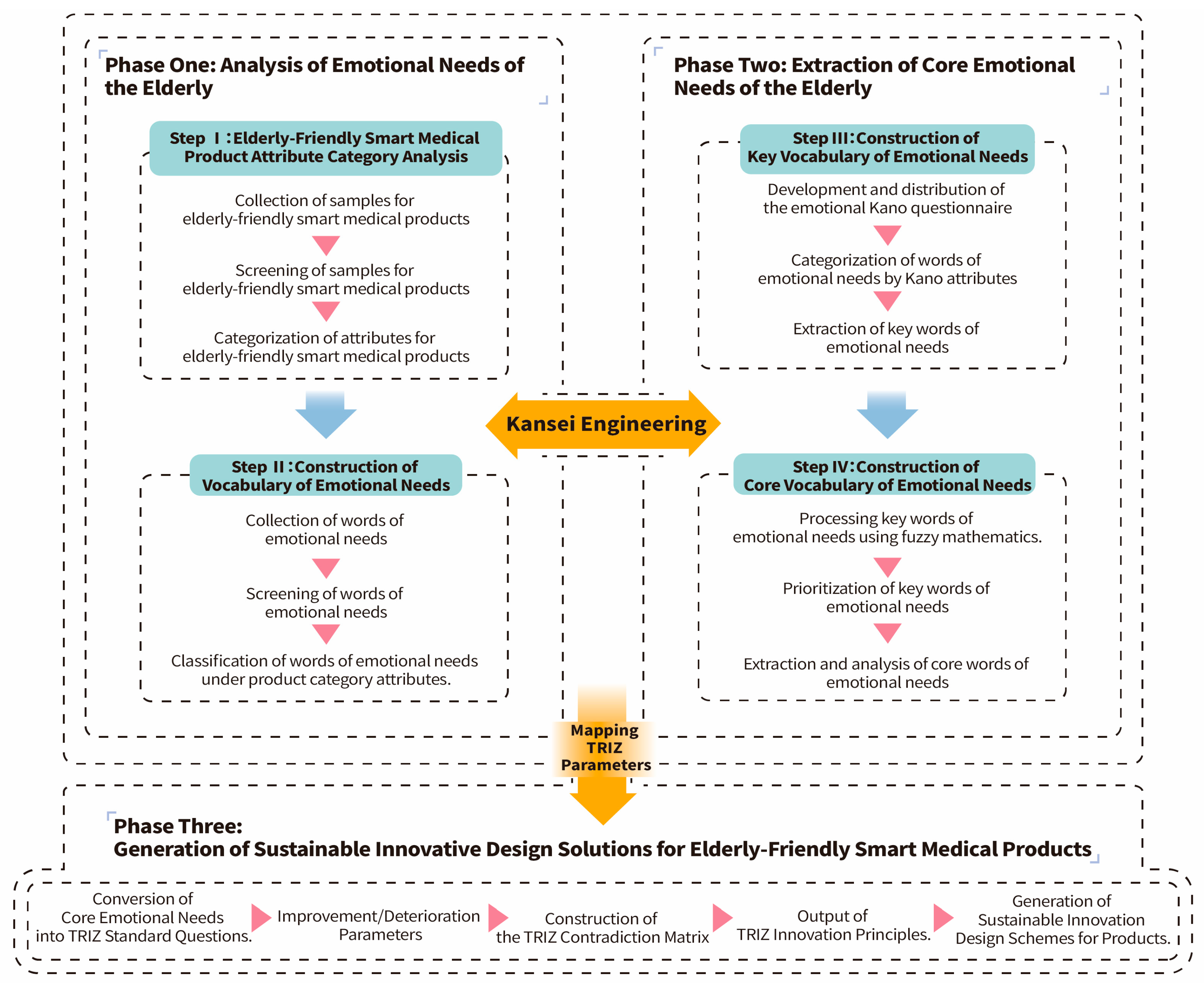
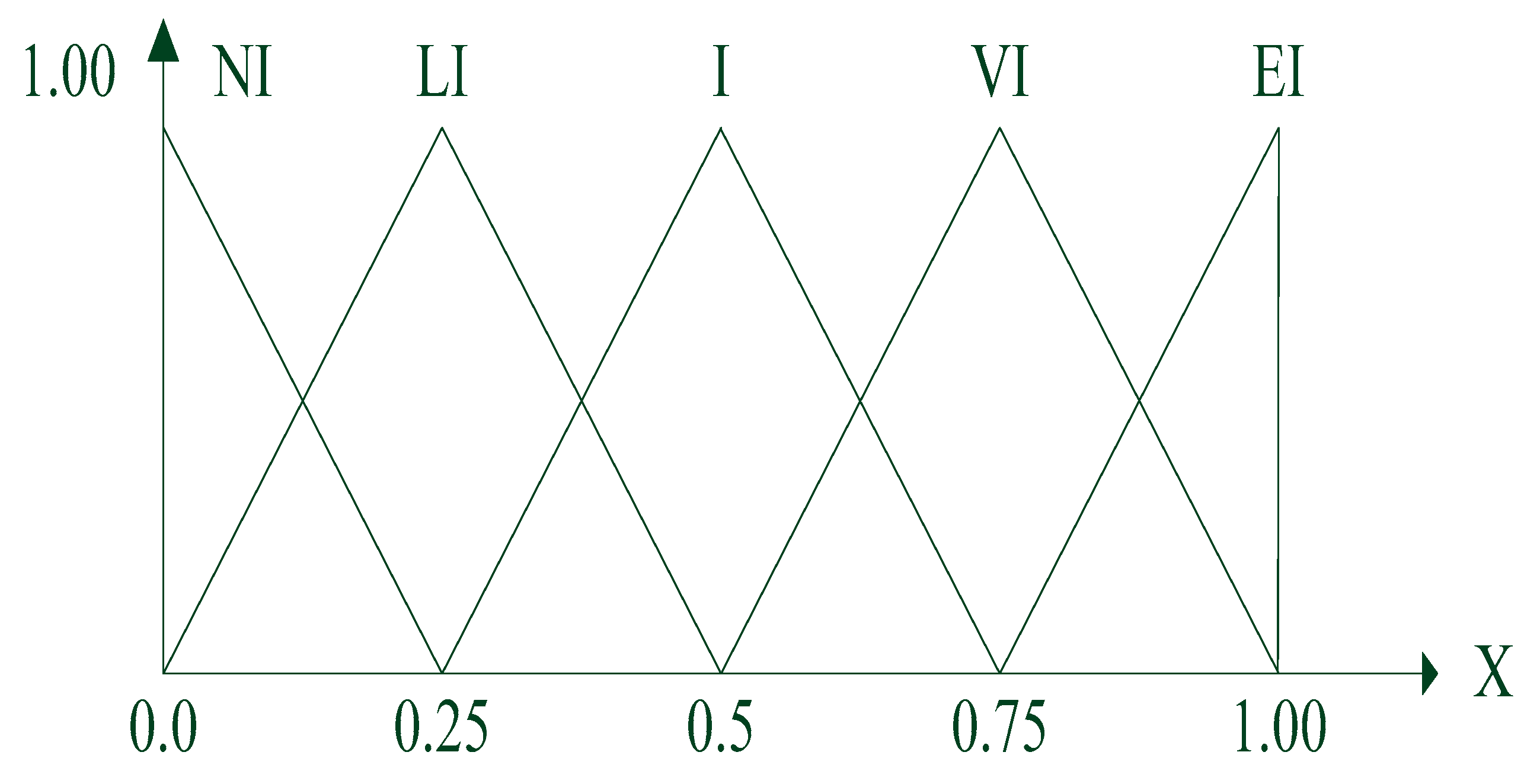
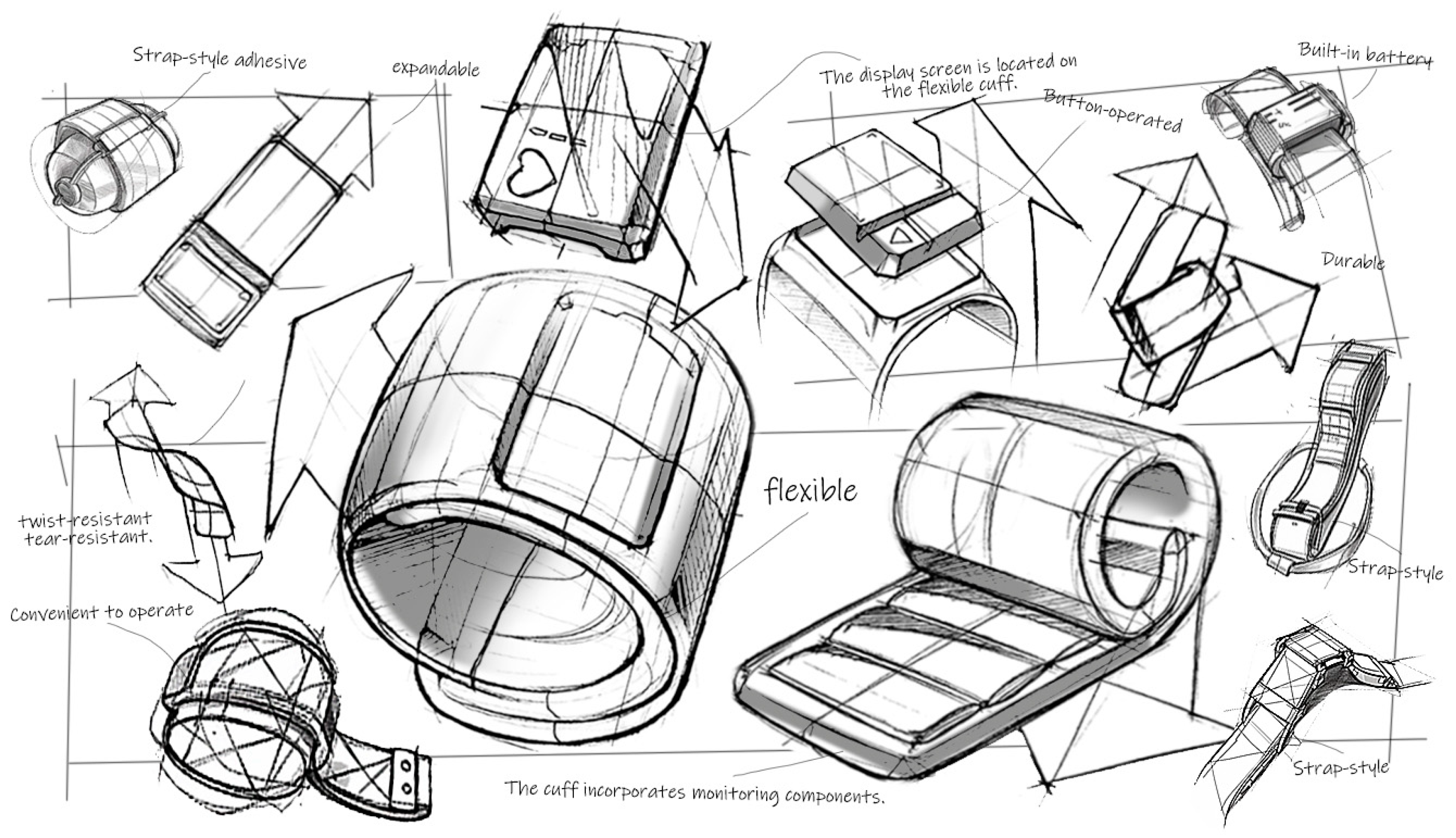

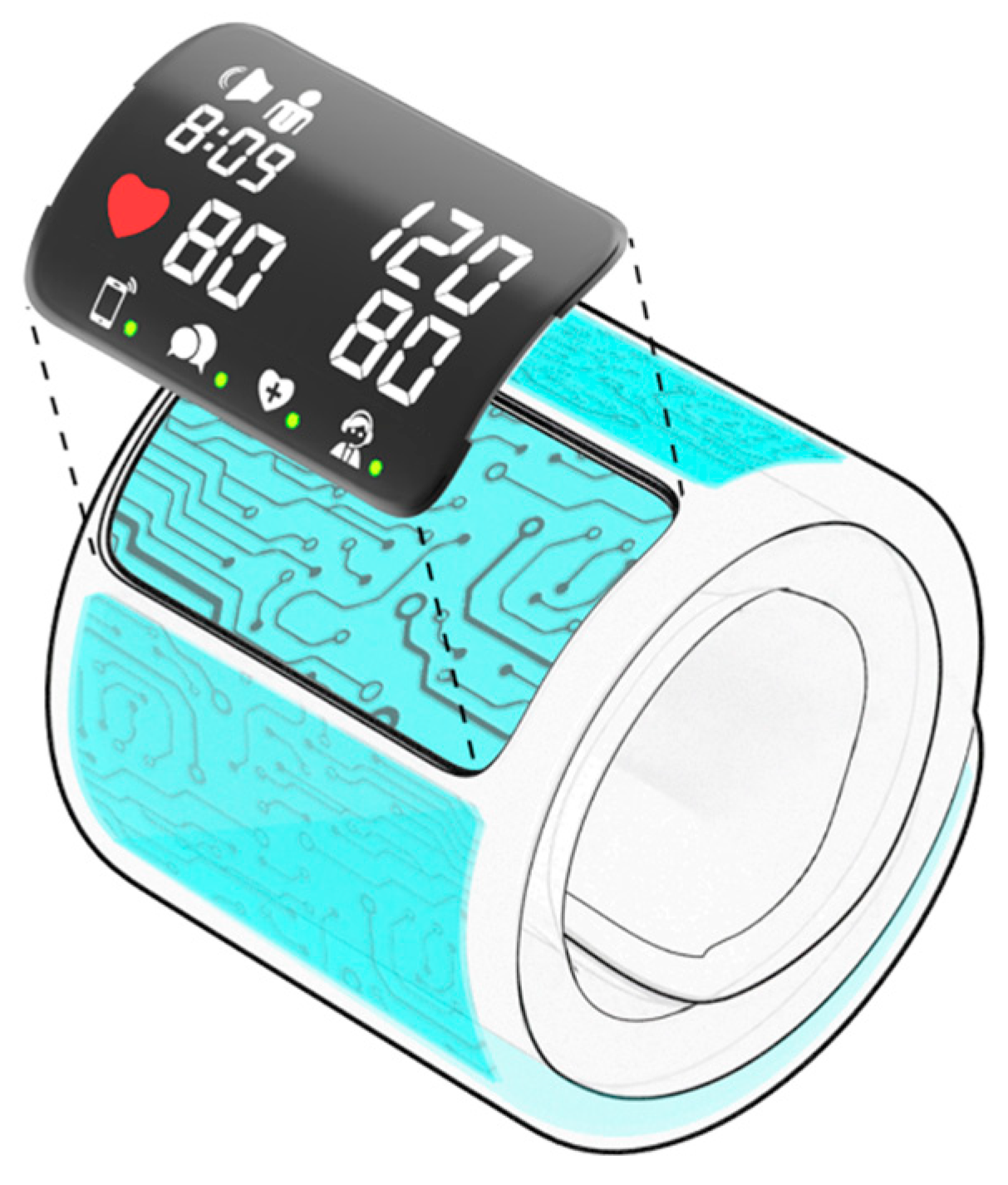
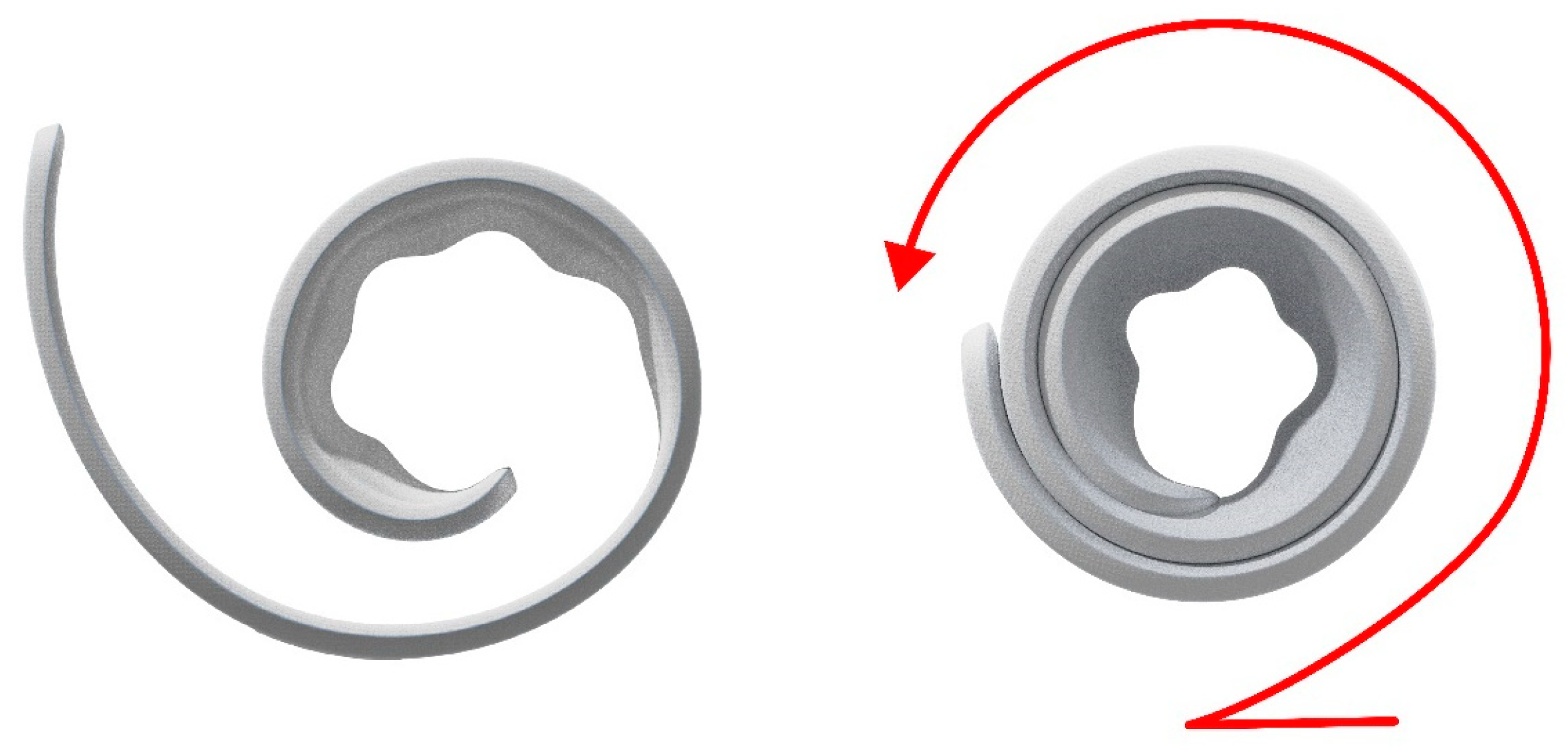
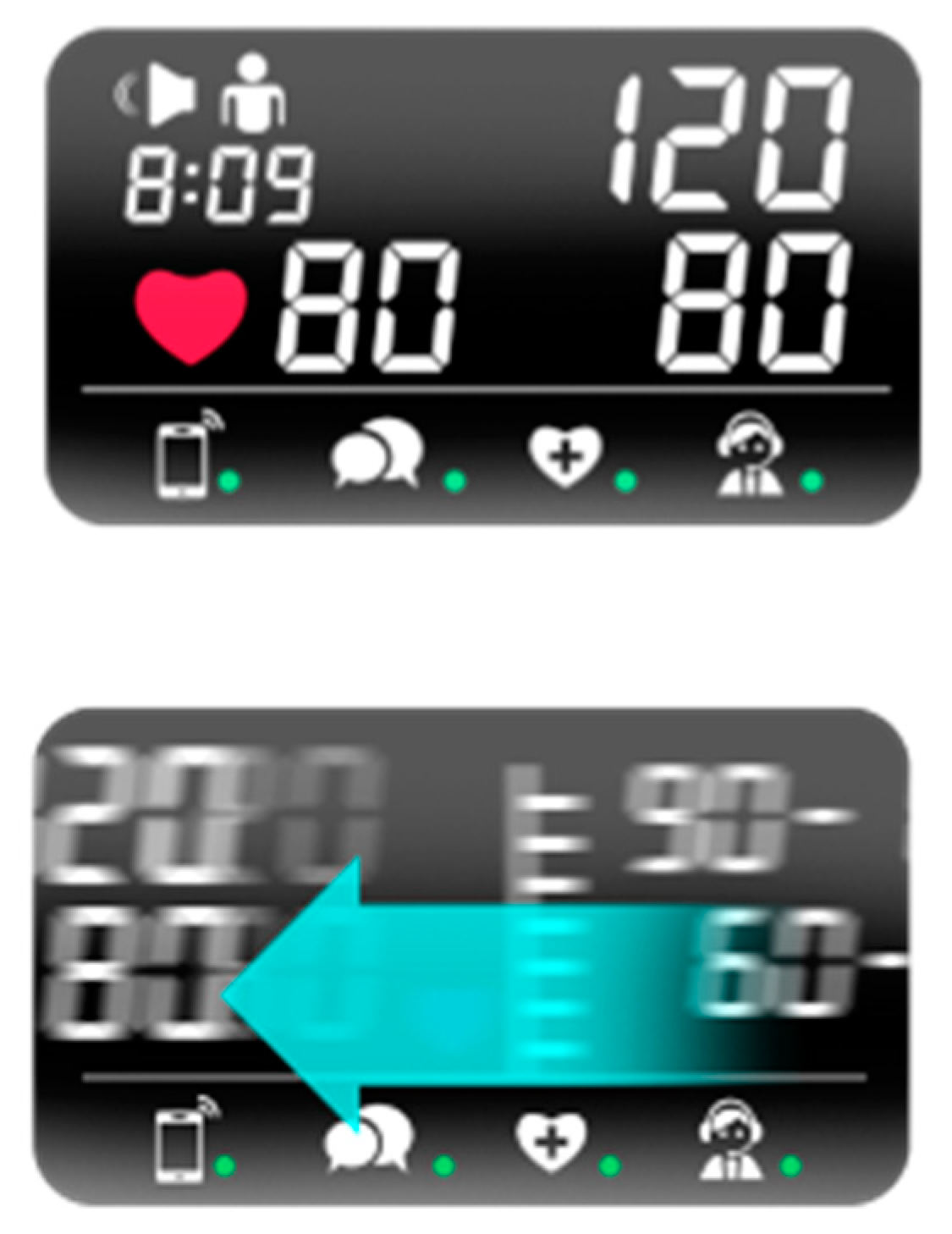

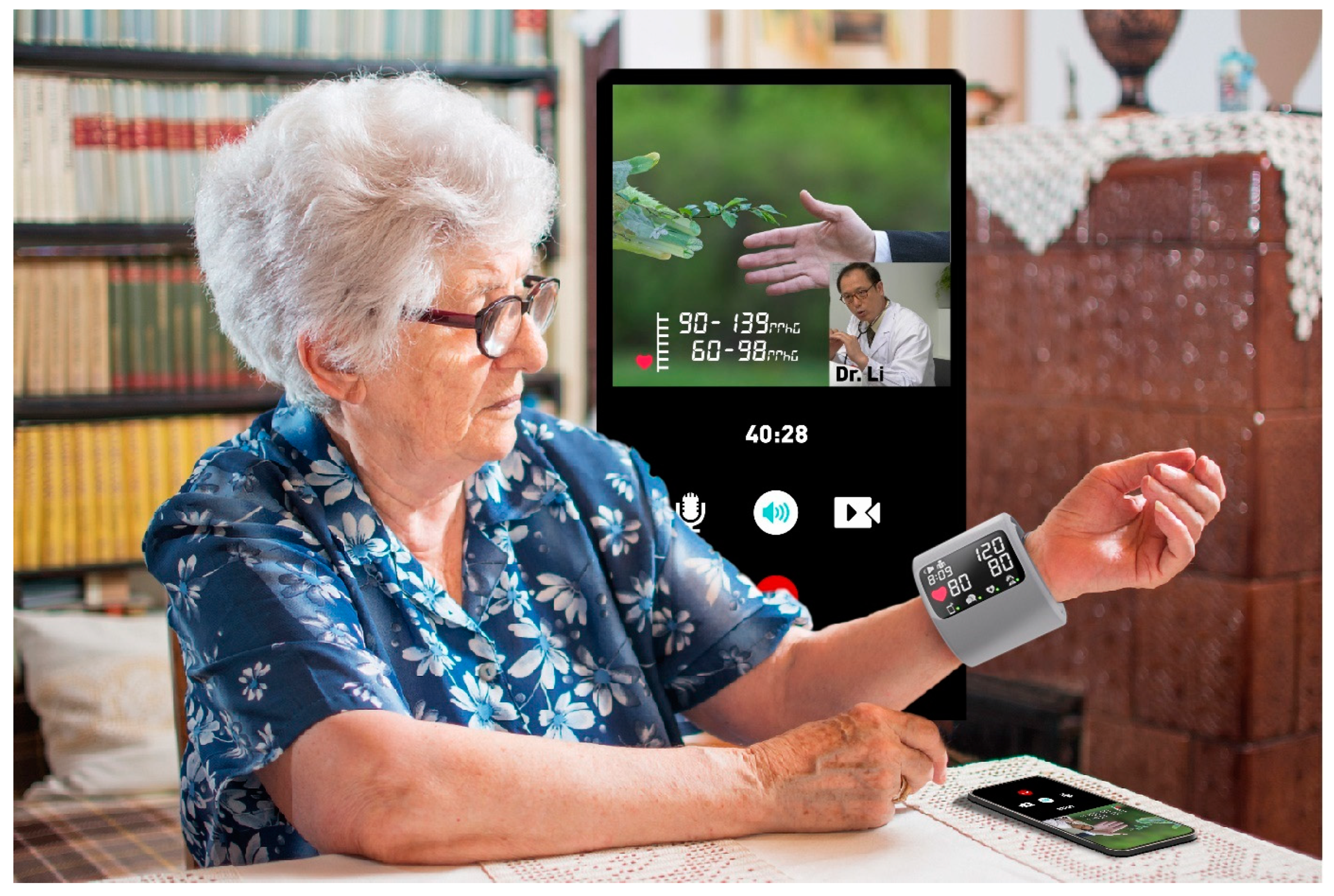
| Options | Like | Expect | Neutral | Accept | Dislike | |
|---|---|---|---|---|---|---|
| Question | ||||||
| Functional attribute provided | ||||||
| Functional attribute not provided | ||||||
| User Functional Attribute Requirements | Functional Attribute Not Provided | |||||
|---|---|---|---|---|---|---|
| Like EI | Expect VI | Neutral I | Accept LI | Dislike NI | ||
| Functional attribute provided | Like EI | Q | A | A | A | O |
| Expect VI | R | I | I | I | M | |
| Neutral I | R | I | I | I | M | |
| Accept LI | R | I | I | I | M | |
| Dislike NI | R | R | R | R | Q | |
| Functional Attribute Number | Functional Attribute Content | Functional Property Frequency | Attribute Category | ||||||||
|---|---|---|---|---|---|---|---|---|---|---|---|
| A | O | M | I | R | Q | Maximum Value | Maximum Percentage | Sum | |||
| Positive-Emotion Word | Negative-Emotion Word | |||||
|---|---|---|---|---|---|---|
| Options | Like EI | Expect VI | Neutral I | Accept LI | Dislike NI | |
| Question | ||||||
| Functionality offered by the smart medical product | ||||||
| Functionality not offered by the smart medical product | ||||||
| Product Serial Number | Product Catalog Pictures | Sample Description |
|---|---|---|
| Sample 1 | 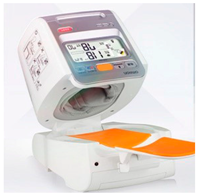 |
|
| Sample 2 | 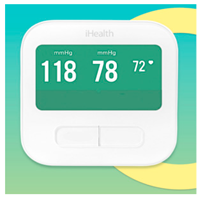 |
|
| … | … | … |
| Sample 118 | 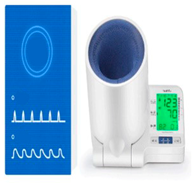 |
|
| Sample 119 |  |
|
| Sample 120 |  |
|
| Product Attribute Category | Words of Emotional Needs |
|---|---|
| Appearance design | Exquisite, colorful, small, stable body, curved or round |
| Functionality | Human-centered, accurate measurement, with memory function, adjustable font, adjustable volume, adjustable brightness, with operational tips, simple operation, concise data display, fun, touchscreen, soft lighting |
| Material | Ecofriendly and lightweight |
| Economy | Cheap |
| Durability | Durable, long service life, dirt-resistant |
| Portability | Portable, no assembly required |
| Technical characteristics | Universal, time-saving start up, sophisticated design, cloud processed |
Cloud Processed  | Locally Processed  | |||||
|---|---|---|---|---|---|---|
| Options | Like EI | Expect VI | Neutral I | Accept LI | Dislike Ni | |
| Question | ||||||
| The smart blood pressure monitors can provide cloud processed functional services. (Cloud processed) | ||||||
| The smart blood pressure monitors cannot provide cloud processed functional services. (Locally processed) | ||||||
| Serial No. | Content of the Library of Emotions | Functional-Property Frequency | |||||||||
|---|---|---|---|---|---|---|---|---|---|---|---|
| A | I | M | O | Q | R | Maximum Value | Maximum Percentage | Sum | Attribute Category | ||
| 1 | Accurate measurement–error in displayed value | 8 | 24 | 24 | 49 | 40 | 1 | 49 | 0.33562 | 146 | O |
| 2 | Human-centered–mechanical | 43 | 30 | 11 | 21 | 38 | 3 | 43 | 0.29452 | 146 | A |
| 3 | Adjustable volume–constant-volume | 19 | 37 | 11 | 42 | 36 | 1 | 42 | 0.28767 | 146 | O |
| 4 | Adjustable brightness–constant brightness | 23 | 39 | 9 | 40 | 33 | 2 | 40 | 0.27397 | 146 | O |
| 5 | With memory function– without memory function | 48 | 34 | 7 | 25 | 32 | 0 | 48 | 0.32877 | 146 | A |
| 6 | Adjustable font–single font display | 28 | 43 | 3 | 38 | 34 | 0 | 43 | 0.29452 | 146 | I |
| 7 | With operational tips–without operational tips | 18 | 38 | 14 | 42 | 33 | 1 | 42 | 0.28767 | 146 | O |
| 8 | Simple operation–complex operation | 16 | 26 | 15 | 52 | 35 | 2 | 52 | 0.35616 | 146 | O |
| 9 | Cloud processed–locally processed | 26 | 48 | 6 | 33 | 32 | 1 | 48 | 0.32877 | 146 | I |
| 10 | Universal–specialized | 21 | 41 | 13 | 37 | 31 | 3 | 41 | 0.28082 | 146 | I |
| 11 | Time-saving start up– time-consuming | 45 | 34 | 11 | 21 | 33 | 2 | 45 | 0.30822 | 146 | A |
| 12 | Soft lighting–cold, hard lighting | 23 | 43 | 8 | 39 | 31 | 2 | 43 | 0.29452 | 146 | I |
| 13 | Concise data display–complex data display | 49 | 26 | 13 | 20 | 33 | 5 | 49 | 0.33562 | 146 | A |
| 14 | Fun–uninteresting | 23 | 52 | 4 | 30 | 33 | 4 | 52 | 0.35616 | 146 | I |
| 15 | Lightweight–heavy | 26 | 34 | 4 | 50 | 31 | 1 | 50 | 0.34247 | 146 | O |
| 16 | Small–bulky | 54 | 32 | 5 | 19 | 33 | 3 | 54 | 0.36986 | 146 | A |
| 17 | Stable body–unstable body | 13 | 27 | 18 | 52 | 34 | 2 | 52 | 0.35616 | 146 | O |
| 18 | Curved (round)–straight (square) | 25 | 51 | 1 | 34 | 32 | 3 | 51 | 0.34932 | 146 | I |
| 19 | Touchscreen–keypad | 28 | 46 | 0 | 37 | 32 | 3 | 46 | 0.31507 | 146 | I |
| 20 | Exquisite–rough looking | 27 | 38 | 8 | 41 | 31 | 1 | 41 | 0.28082 | 146 | O |
| 21 | Portable–fixed | 49 | 27 | 9 | 27 | 33 | 1 | 49 | 0.33562 | 146 | A |
| 22 | No assembly required– assembly required | 50 | 28 | 7 | 25 | 33 | 3 | 50 | 0.34247 | 146 | A |
| 23 | Colorful–monochromatic | 30 | 46 | 4 | 30 | 32 | 4 | 46 | 0.31507 | 146 | I |
| 24 | Sophisticated design–crude design | 20 | 31 | 14 | 47 | 32 | 2 | 47 | 0.32192 | 146 | O |
| 25 | Durable–fragile | 15 | 21 | 15 | 59 | 32 | 4 | 59 | 0.40411 | 146 | O |
| 26 | Cheap–expensive | 52 | 35 | 6 | 24 | 29 | 0 | 52 | 0.35616 | 146 | A |
| 27 | Ecofriendly–contaminated | 21 | 36 | 6 | 50 | 31 | 2 | 50 | 0.34247 | 146 | O |
| 28 | Long service life–short service life | 21 | 22 | 13 | 55 | 31 | 4 | 55 | 0.37671 | 146 | O |
| 29 | Dirt-resistant–stain-prone | 50 | 32 | 11 | 22 | 29 | 2 | 50 | 0.34247 | 146 | A |
| Serial No. | Core Word Pairs of Emotional Needs | Qij | Oij | Pij | Defuzzification Value | Importance Ranking |
|---|---|---|---|---|---|---|
| 2 | Human-centered–mechanical | 0.448 | 0.648 | 0.779 | 0.631 | 6 |
| 5 | With memory function– without memory function | 0.453 | 0.655 | 0.784 | 0.637 | 4 |
| 11 | Time-saving start up– time-consuming | 0.453 | 0.653 | 0.786 | 0.636 | 5 |
| 13 | Concise data display–complex data display | 0.463 | 0.660 | 0.787 | 0.642 | 3 |
| 16 | Small–bulky | 0.462 | 0.662 | 0.787 | 0.643 | 2 |
| 21 | Portable–fixed | 0.450 | 0.650 | 0.774 | 0.631 | 6 |
| 22 | No assembly required– assembly required | 0.467 | 0.667 | 0.790 | 0.648 | 1 |
| 26 | Cheap–expensive | 0.443 | 0.644 | 0.778 | 0.627 | 7 |
| 29 | Dirt-resistant–stain-prone | 0.443 | 0.641 | 0.774 | 0.625 | 8 |
| Improvement Parameters | Deterioration Parameters | ||
|---|---|---|---|
| 22 Loss of Energy | 36 Device or System Complexity | 35 Adaptability or Versatility | |
| 7 Volume of moving object | 7/15/13/16 | ||
| 33 Ease of operation | 32/26/12/17 | 15/34/1/16 | |
| Innovation Principle | Service Optimization Solutions |
|---|---|
| No. 7 (Nesting) | Solution S1: Embed the internal structure of the smart blood pressure monitor inside the cuff and the display outside the cuff to form an integrated design. |
| No. 17 (Transition to a new dimension) | Solution S2: Folding design for the smart blood pressure monitor. |
| No. 1 (Segmentation) | Solution S3: Display the measurement data of the smart blood pressure monitor in a sequential manner. |
| No. 15 (Dynamicity) | Solution S4: Upload smart blood pressure monitor measurement data to the cloud. |
| Source | Topic | The Previous Studies |
|---|---|---|
| Shi et al. [24], Chanyachatchawan et al. [19], Guo et al. [76], Jiao and Qu [21], Song et al. [45], Wang [18] | User-centered product design |
|
| Huang et al. [77], Wang et al. [26], Cao et al. [28], Ding and Bai [27] |
| |
| Bigorra et al. [78], Lee et al. [79], Xu et al. [31] |
| |
| Lo et al. [80], Montes et al. [72], Lyu et al. [30] |
| |
| Yang et al. [25], Lee et al. [81], Wang [82] | Product innovation design |
|
| Vinodh et al. [10], Wang et al. [1], Sousa-Zomer and Cauchick Miguel [83] |
| |
| Source | Topic | Strengths of the Present Study |
| Present study | User-centered sustainable innovation in product design. |
|
| ||
| ||
| ||
|
Disclaimer/Publisher’s Note: The statements, opinions and data contained in all publications are solely those of the individual author(s) and contributor(s) and not of MDPI and/or the editor(s). MDPI and/or the editor(s) disclaim responsibility for any injury to people or property resulting from any ideas, methods, instructions or products referred to in the content. |
© 2024 by the authors. Licensee MDPI, Basel, Switzerland. This article is an open access article distributed under the terms and conditions of the Creative Commons Attribution (CC BY) license (https://creativecommons.org/licenses/by/4.0/).
Share and Cite
Shie, A.-J.; Xu, E.-M.; Ye, Z.-Z.; Meng, Q.-F.; Wu, Y.J. Sustainable Innovative Design of Elderly-Friendly Smart Medical Products: An Integrated Model. Sustainability 2024, 16, 7580. https://doi.org/10.3390/su16177580
Shie A-J, Xu E-M, Ye Z-Z, Meng Q-F, Wu YJ. Sustainable Innovative Design of Elderly-Friendly Smart Medical Products: An Integrated Model. Sustainability. 2024; 16(17):7580. https://doi.org/10.3390/su16177580
Chicago/Turabian StyleShie, An-Jin, En-Min Xu, Zhen-Zhen Ye, Qing-Feng Meng, and Yenchun Jim Wu. 2024. "Sustainable Innovative Design of Elderly-Friendly Smart Medical Products: An Integrated Model" Sustainability 16, no. 17: 7580. https://doi.org/10.3390/su16177580







